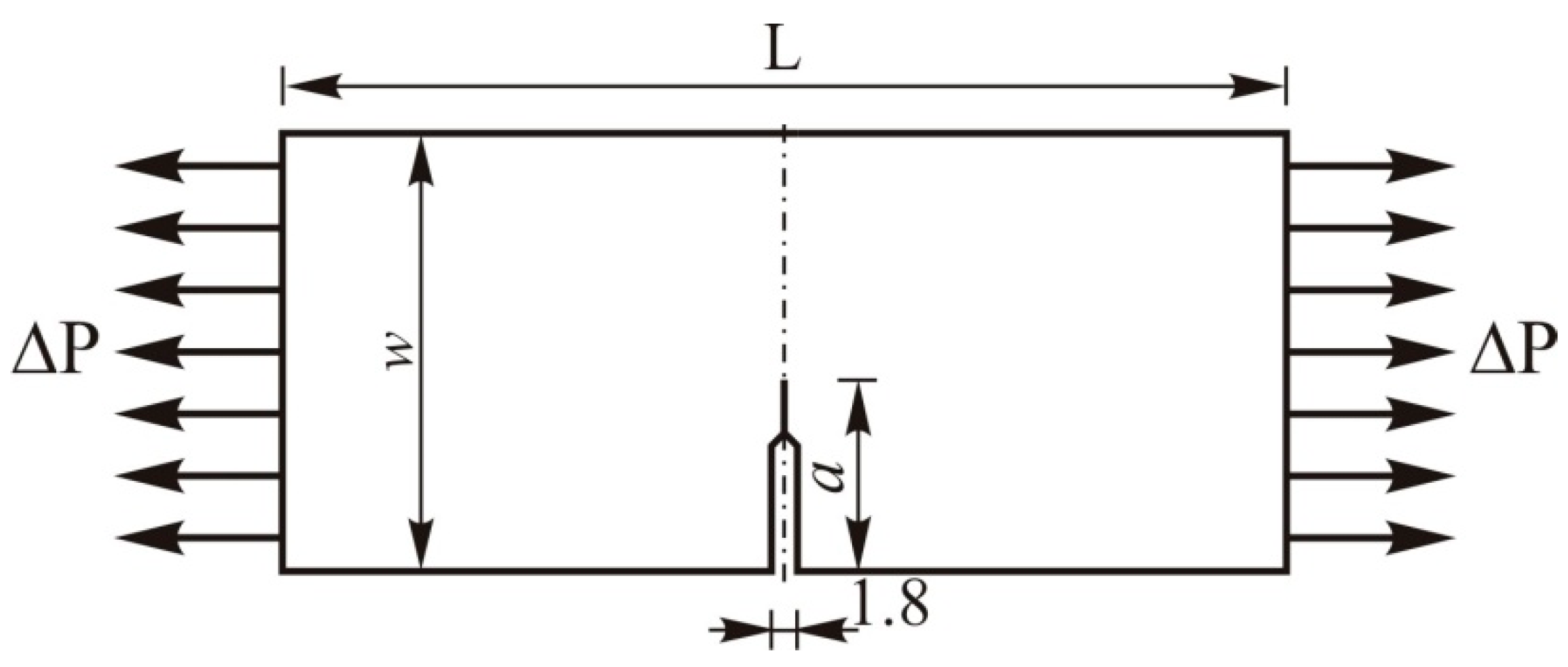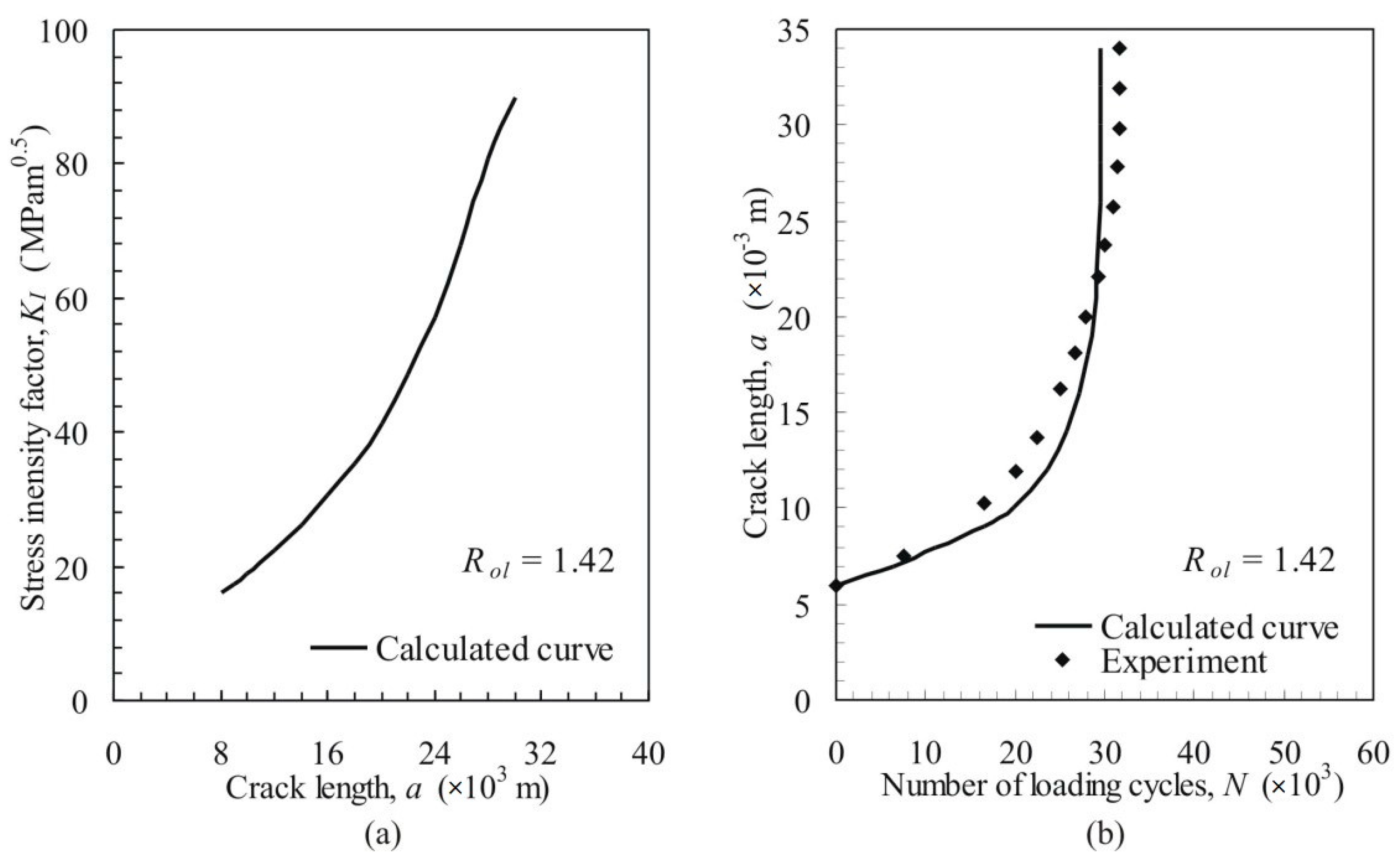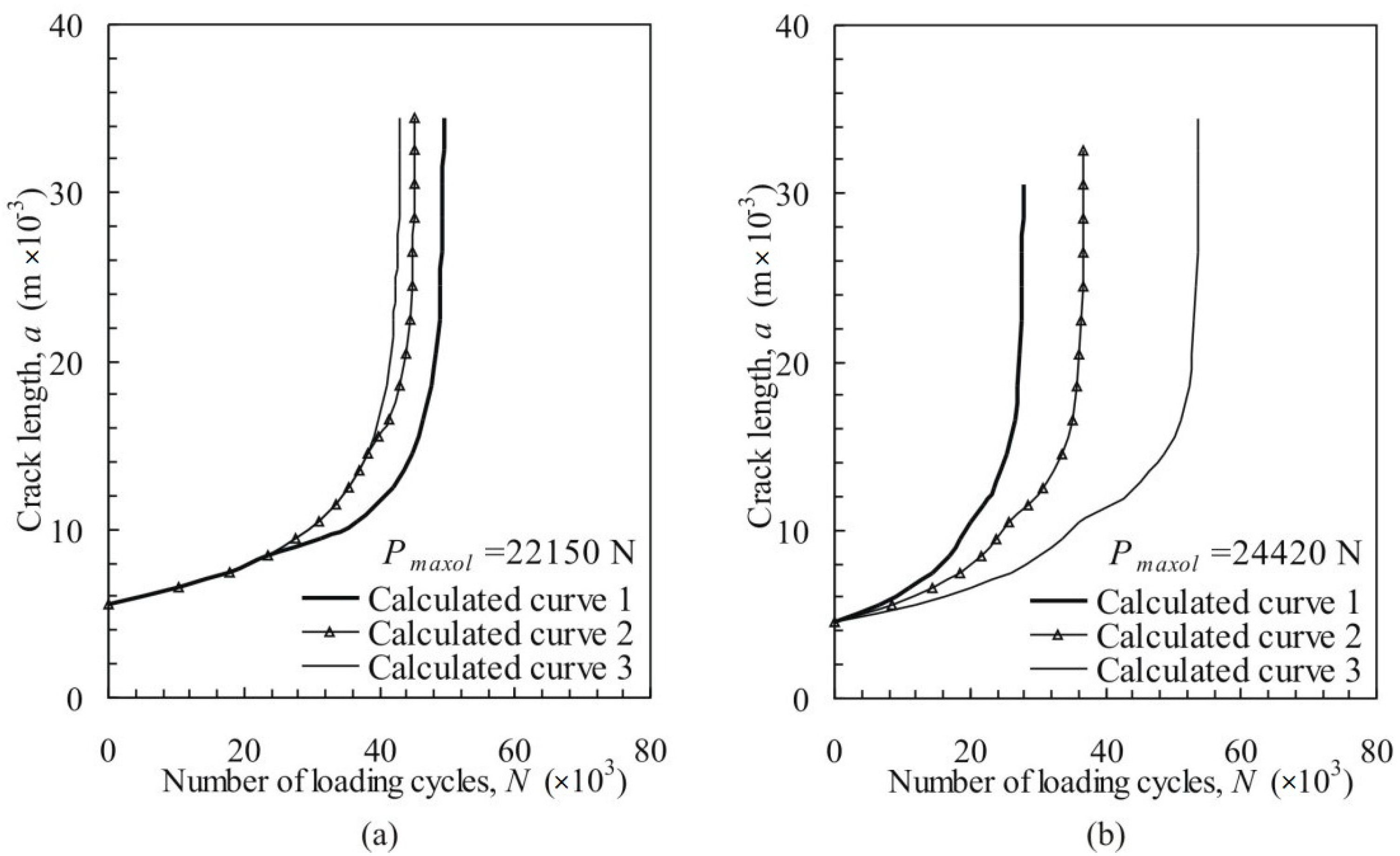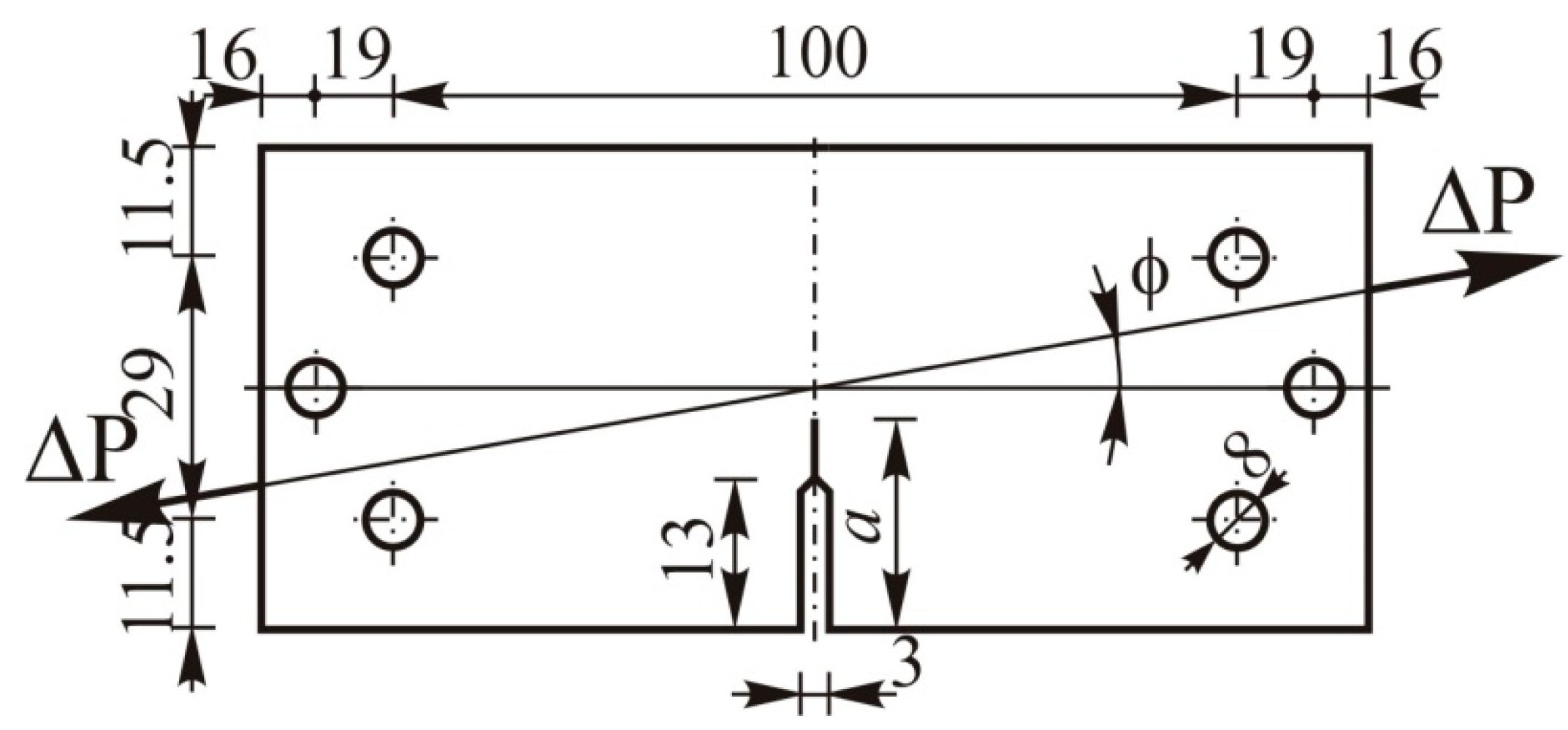Computational Failure Analysis under Overloading
Abstract
:1. Introduction
2. Driving Mode Analysis under Cyclic Loading
3. Crack Growth Evolution Taking into Account the Retardation Effect
4. Residual Strength Design Using Developed Computational Framework
4.1. Fatigue Evaluations under Cyclic Loading with Overload
4.2. The Effect of Overload Crack Length and the Stress Ratio Effect on the Fatigue Strength
4.3. Fatigue Evaluations under Mixed Mode Loading with Overload
5. Conclusions
Author Contributions
Funding
Data Availability Statement
Acknowledgments
Conflicts of Interest
References
- Schijve, J.; Broek, D. Crack propagation: The results of a test programme based on a gust spectrum with variable amplitude loading. Aircraft Eng. Aerospace Techn. 1962, 34, 314–316. [Google Scholar] [CrossRef]
- Elber, W. The significance of fatigue crack closure. In Damage Tolerance in Aircraft Structures; ASTM STP: Philadelphia, PA, USA, 1971; Volume 486, pp. 230–242. [Google Scholar]
- Christensen, R.H. Fatigue crack. In Fatigue Cracking, Fatigue Damage and Their Detection, Metal Fatigue; Sines, G., Waisman, J.L., Eds.; McGraw-Hill Book Co.: New York, NY, USA, 1959; pp. 376–412. [Google Scholar]
- Jones, R.E. Fatigue crack growth retardation after single-cycle peak overload in Ti-6Al-4V titanium alloy. Eng. Fract. Mech. 1973, 5, 585–604. [Google Scholar] [CrossRef]
- Suresh, S. Micromechanisms of fatigue crack growth retardation following overloads. Eng. Fract. Mech. 1983, 18, 577–593. [Google Scholar] [CrossRef] [Green Version]
- Nicoletto, W. Fatigue crack-tip field measurements. In Nonlinear Fracture Mechanics; ASTM STP: Philadelphia, PA, USA, 1989; Volume 995, pp. 415–432. [Google Scholar]
- Budiansky, B.; Hutchinson, J.W. Analysis of closure in fatigue crack growth. ASME J. Appl. Mech. 1978, 45, 267–276. [Google Scholar] [CrossRef]
- Dugdale, D.S. Yielding of steel sheets containing slits. J. Mech. Phys. Solids 1960, 8, 100–104. [Google Scholar] [CrossRef]
- Barenblatt, G.I. The mathematical theory of equilibrium cracks in brittle fracture. In Advances in Applied Mechanics 7; USSR Academy of Sciences: Moscow, Russia, 1962; pp. 55–129. [Google Scholar]
- Ohji, K.; Ogura, K.; Yoshiji, O. Cyclic analysis of a propagating crack and its correlation with fatigue crack growth. Eng. Fract. Mech. 1975, 7, 457–464. [Google Scholar] [CrossRef]
- Willenborg, J.D.; Engle, R.M.; Wood, H.A. A Crack Growth Retardation Model Using an Effective Stress Concept; Report AFFDL-TM-71-1-FBR; Air Force Flight Laboratory, Wright-Patterson Air Force Base: Dayton, OH, USA, 1971. [Google Scholar]
- Wheeler, O.E. Spectrum loading and crack growth. J. Bas. Eng. Trans. ASME Ser. D 1972, 94, 181–186. [Google Scholar] [CrossRef]
- Fleck, N.A. Finite element analysis of plasticity induced crack closure under plane strain conditions. Eng. Fract. Mech. 1986, 25, 441–449. [Google Scholar] [CrossRef]
- Wang, C.H.; Rose, L.R.F.; Newman, J.C. Closure of plane-strain cracks under large-scale yielding conditions. Fatigue Fract. Eng. Mater. Struct. 2002, 25, 127–139. [Google Scholar] [CrossRef]
- Sander, M.; Richard, H.S. Lifetime predictions for real loading situations–concepts and experimental results of fatigue crack growth. Int. J Fatigue 2003, 25, 999–1005. [Google Scholar] [CrossRef]
- NASGRO. Fatigue Crack Growth Computer Program “NASGRO”; Version 3.0-Reference Manual, JSC-22267B; NASA, Lyndon B. Johnson Space Center: Houston, TX, USA, 2000. [Google Scholar]
- Pavlou, D.G.; Vlachakis, N.V.; Pavlou, M.G.; Vlachakis, V.N. Estimation of fatigue crack growth retardation due to crack branching. Comp. Mater. Sci. 2004, 29, 446–452. [Google Scholar] [CrossRef]
- Huang, X.; Moan, T.; Weicheng, C. An engineering model of fatigue crack growth under variable amplitude loading. Int. J. Fatigue 2008, 30, 2–10. [Google Scholar] [CrossRef]
- Mohanty, J.R.; Verma, B.B.; Ray, P.K. Prediction of fatigue life with interspersed mode-I and mixed-mode (I and II) overloads by an exponential model: Extensions and improvements. Eng. Fract. Mech. 2009, 76, 454–468. [Google Scholar] [CrossRef]
- Jones, R.; Molent, L.; Pitt, S. Crack growth of physically small cracks. Int. J. Fatigue 2007, 29, 1658–1667. [Google Scholar] [CrossRef]
- Harmain, G.A. A model for predicting the retardation effect following a single overload. Theor. Appl. Fract. Mech. 2010, 53, 80–88. [Google Scholar] [CrossRef]
- Boljanović, S.; Maksimović, S. Computational mixed mode failure analysis under fatigue loadings with constant amplitude and overload. Eng. Fract. Mech. 2017, 174, 168–179. [Google Scholar] [CrossRef]
- Kujawski, D. A new (ΔK+Kmax)0.5 driving force parameter for crack growth in aluminium alloy. Int. J. Fatigue 2001, 23, 733–740. [Google Scholar] [CrossRef]
- Boljanović, S.; Maksimović, S.; Carpinteri, A. Fatigue-resistance evaluations for mixed mode damages under constant amplitude and overload. Theor. Appl. Fract. Mech. 2020, 108, 102599. [Google Scholar] [CrossRef]
- Zhan, W.; Lu, N.; Zhang, C. A new approximate model for the R-ratio effect on fatigue crack growth rate. Eng. Fract. Mech. 2014, 119, 85–96. [Google Scholar] [CrossRef]
- Richard, H.A.; Linning, W.; Henn, K. Fatigue crack propagation under combined loading. Forensic Eng. 1991, 3, 99–109. [Google Scholar]
- Carpinteri, A.; Spagnoli, A.; Vantadori, S.; Bagni, C. Structural integrity assessment of metallic components under multiaxial fatigue: The C-S criterion and its evaluation. Fatigue Fract. Eng. Mater. Struct. 2013, 36, 870–883. [Google Scholar] [CrossRef]
- Carpinteri, A.; Spagnoli, A.; Ronchei, C.; Scorza, D.; Vantadori, S. Critical plane criterion for fatigue life calculation: Time and frequency domain formulations. Procedia Eng. 2015, 101, 518–523. [Google Scholar] [CrossRef]
- Huang, X.; Moan, T. Improved modeling of the effect of R-ratio on crack growth rate. Int. J. Fatigue 2007, 29, 591–602. [Google Scholar] [CrossRef]
- Antunes, F.V.; Borrego, L.F.P.; Costa, J.M.; Ferreira, J.M. A numerical study of fatigue crack closure induced by plasticity. Fatigue Fract. Eng. Mater. Struct. 2004, 27, 825–835. [Google Scholar] [CrossRef]
- Rushton, P.A.; Taheri, F. Prediction of crack growth in 350WT steel subjected to constant amplitude with over- and under-loads using a modified wheeler approach. Mar. Struct. 2003, 16, 517–539. [Google Scholar] [CrossRef]
- Kumar, R. Prediction of delay cycles due to instant of single overload cycles. Eng. Fract. Mech. 1992, 42, 563–571. [Google Scholar] [CrossRef]
- Tanaka, K. Fatigue crack propagation from a crack inclined to the cyclic tensile axis. Eng. Fract. Mech. 1974, 6, 493–507. [Google Scholar] [CrossRef]
- Chao, Y.J.; Liu, S. On the failure of cracks under mixed-mode loads. Int. J. Fract. 1997, 87, 201–223. [Google Scholar] [CrossRef]







| Rol | ∆Pol (N) | N exp. (Cycles) [32] | N cal. (Cycles) |
|---|---|---|---|
| 1.42 | 16,677 | 31,250 | 29,620 |
| 1.67 | 19,620 | 38,513 | 32,600 |
| 1.88 | 22,072 | 57,140 | 50,340 |
Publisher’s Note: MDPI stays neutral with regard to jurisdictional claims in published maps and institutional affiliations. |
© 2021 by the authors. Licensee MDPI, Basel, Switzerland. This article is an open access article distributed under the terms and conditions of the Creative Commons Attribution (CC BY) license (https://creativecommons.org/licenses/by/4.0/).
Share and Cite
Boljanović, S.; Carpinteri, A. Computational Failure Analysis under Overloading. Metals 2021, 11, 1509. https://doi.org/10.3390/met11101509
Boljanović S, Carpinteri A. Computational Failure Analysis under Overloading. Metals. 2021; 11(10):1509. https://doi.org/10.3390/met11101509
Chicago/Turabian StyleBoljanović, Slobodanka, and Andrea Carpinteri. 2021. "Computational Failure Analysis under Overloading" Metals 11, no. 10: 1509. https://doi.org/10.3390/met11101509







